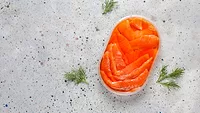Wyoming Researchers Find Substance that Helps Listeria Survive
Source (text below and photo at left): University of Wyoming. In photo: Kurt Miller (left), a UW professor of molecular biology, and Volkan Koseoglu, a UW student in in the Molecular and Cellular Life Sciences Ph.D. program, observe clumping of cells in exopolysaccharide (EPS). The two researchers contributed to a paper that shows that EPS greatly increases survival to disinfectants and desiccation of Listeria monocytogenes.
University of Wyoming researchers have discovered a substance that greatly increases the survival of Listeria monocytogenes, a foodborne bacterial pathogen that contaminates processed meat and milk products, as well as fresh produce.
Researchers hope the discovery will lead to the development of techniques to better combat the pathogen and to improve food safety.
Mark Gomelsky, a professor in UW’s Department of Molecular Biology, and other researchers discovered and characterized a substance, called exopolysaccharide (EPS), that listeria secretes on its cell surface under certain conditions. The EPS coats bacterial cells and makes them form aggregates or clumps, which are strongly protected from commonly used disinfectants and desiccation (extreme drying).
“We think that EPS plays a significant role in survival of Listeria in the environment, during food storage, processing and transportation,” Gomelsky says. “Listeria rarely causes serious disease in healthy individuals but, in immune-compromised people, elderly and pregnant women, it can be deadly, causing as much as 20 percent to 25 percent mortality.”
Gomelsky is a senior writer of a paper, titled “Cyclic di-GMP-Dependent Signaling Pathways in the Pathogenic Firmicute Listeria monocytogenes," that was published August 7 in Public Library of Science (PLoS) Pathogens.
Li-Hong Chen, a visiting scientist from Inner Mongolia Agricultural University in China, conducted the bulk of the research, Gomelsky says. Kurt Miller, a UW professor of molecular biology; Volkan Koseoglu, a UW student in in the Molecular and Life Sciences Ph.D. program; Tuzun Guvener, a former UW post-doctoral fellow; and Joseph Reed, a former UW molecular biology student, contributed to the paper.
Looking for quick answers on food safety topics?
Try Ask FSM, our new smart AI search tool.
Ask FSM →
“We were studying the cell signaling in Listeria, by a molecule called c-di-GMP,” Gomelsky says. “What we discovered, quite unexpectedly, is that a strain with a high level of this signaling molecule overproduces EPS.”
For years, the research community has debated whether Listeria could produce EPS, which is a sugar polymer. But Gomelsky says he, and other scientists who wrote the paper, now have proven that it does.
Testing resistance
“You can envision EPS as a protective coat around the cell,” Miller says.
To test what role EPS plays in protecting listerial strains, Koseoglu used various chemical agents, including bleach, hydrogen peroxide and other disinfectants commonly used in the food processing industry. Chemicals were effective in killing the bacteria that did not produce the EPS coat, but were much less effective in killing the ones that produced EPS. When bleach was used, cells in the clumps coated by EPS were found to be strongly protected.
“You can readily kill listerial cells with a disinfectant like bleach, but you can’t easily kill clumped cells,” Koseoglu says.
Gomelsky concurs.
“Pour bleach on the EPS-coated cells, let them soak 10 minutes, remove the bleach, and you will still find plenty of bacteria surviving this challenge,” Gomelsky says. “The resistance to bleach in EPS-coated clumps increases by more than 10 million fold. To me, this number is mind-boggling.”
The research also included experiments with mice that took place at the University of Kentucky. Sarah D’Orazio, an associate professor of microbiology, immunology and molecular genetics there, and her associate, Tanya Myers-Morales, studied listerial infection in mice via oral ingestion of contaminated food.
She used a model that closely mimics all phases of human disease -- from ingestion of contaminated food to gastrointestinal problems.
“The mice got sick at similar rates, whether they ate EPS-coated or non-coated bacteria,” Gomelsky says. “EPS did not change much the ability of Listeria to cause disease, but survival of Listeria on food products prior to consumption may be greatly affected by EPS.”
Currently, the UW researchers are determining the sugar composition of EPS.
“This may provide crucial information as to how to remove EPS from Listeria. We also want to determine what signals make Listeria produce EPS,” Miller says. “The long-term strategy is to discover how to stop Listeria from producing EPS and how to make EPS-coated Listeria less resistant to disinfection.”
This work was supported, in part, by a postdoctoral fellowship from The China Scholarship Council, and by grants from UW’s Agricultural Experimental Station, the National Science Foundation (NSF) and National Institutes of Health. Reed was a recipient of undergraduate research scholarships from the NSF Wyoming Experimental Program to Stimulate Competitive Research (EPSCoR) and the Wyoming NASA Space Grant Consortium.







